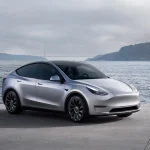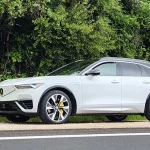
“Death of the internal combustion engine” is now a thing”Death of the internal combustion engine” is now a thing
The very first working four-cycle internal-combustion engine was invented by Niklaus Otto in 1876, and in due course it changed the world.
A quarter of a century later, gasoline engines, steam-powered vehicles, and electric drive competed on an equal basis, but by 1915, it was clear the gasoline engine would triumph.
The next 100 years brought more than 1.2 billion vehicles to the surface of our planet, the vast majority fueled by gasoline burned in internal-combustion engine.
DON’T MISS: China developing timetable to end sales, production of gasoline cars
Six weeks ago, state media in China revealed that the country was evaluating in what year it should end the sale of new vehicles powered by gasoline and diesel fuel.
The Chinese car market is the world’s largest, at 31 million vehicles last year. Carmakers have no choice but to follow the country’s rules if they want to remain relevant globally.
Now, suddenly, we starting to hear serious discussion about “the end of the internal-combustion engine.”
2017 Chevrolet Bolt EV
The first such article that came across our desk actually preceded the Chinese announcement.
In August, The Economist published a story titled simply, “The death of the internal combustion engine.”
“It had a good run,” the story began. “But the end is in sight for the machine that changed the world.”
“Rapid gains in battery technology favour electric motors instead,” it continued, noting the gains in range from the newest mass-market electric cars like the Chevrolet Bolt EV.
That was a one-off; we made a note and moved on.
Cash for Clunkers tradeins: Mercury Sable and Toyota Camry
Then, last week, came another story, this one in The Washington Post.
Saddled with the lengthy title, “Why 2017 will go down as the beginning of the end of the internal combustion engine,” the piece covers some of the same ground.
It also cites three specific reasons why 2017 may prove in retrospect to have been a tipping point for electric cars.
CHECK OUT: Hey, media, get it straight: “electrified” is NOT “electric,” and the difference matters
First was the China announcement, which followed similar plans from small and not terribly influential markets like Norway and The Netherlands.
Second was the arrival of the Tesla Model 3. Although that car is now in “production hell,” to quote Tesla CEO Elon Musk, if we assume it ultimately sells in the tens of thousands a month, that will be a new sales level.
Third are plans by many automakers for an “all-electric future,” although like many writers, the different between electric cars and “electrified” cars is glossed over—and it’s an important one.
Mazda SkyActiv-X engine: three changes to hardware and sensor ancillary equipmentMazda 2.0-liter SkyActiv-X engine with spark-controlled compression ignition (SPCCI)Mazda 2.0-liter SkyActiv-X engine with spark-controlled compression ignition (SPCCI)
While automakers and their engineers are going to greater and more complex lengths to bring the energy efficient of engines into the 40-to-50-percent range, they still run on fossil fuels.
For the vast majority of North American drivers today, 1 mile driven in an electric car has lower wells-to-wheels carbon footprint than the average new gasoline vehicle even if charged on the dirtiest, most coal-heavy grids.
Charged on cleaner grids or renewable energy, no vehicle with a combustion engine will ever get as low in carbon as that electric car.
Still, it’s important to keep in mind that the first modern battery-electric vehicle hit the market less than seven years ago.
The increasing severity of climate-change effects and rapid progress in cost reductions for lithium-ion batteries together have taken us to a place probably unimaginable seven years ago.
Zero S electric motorcycle charging next to Nissan Leaf during Ride the Future Tour [Ben Rich]
It may well be 50 years before the last passenger vehicle with an internal-combustion engine is sold anywhere in the world.
But for the first time, that possibility is being discussed—and not in tones of horror either.
How times change.
_______________________________________
Follow GreenCarReports on Facebook and Twitter.
View original article at: “https://www.greencarreports.com//news/1113429_death-of-the-internal-combustion-engine-is-now-a-thing”
Add a comment Cancel reply
Categories
- Activism (1)
- Adventure (1)
- Advertising (2)
- Agriculture (1)
- Air pollution (4)
- Air transport (3)
- aluminium (2)
- Amazon (3)
- Animals (1)
- Apple (2)
- Architecture (1)
- Arctic (1)
- Artificial intelligence (1)
- Augmented Reality (1)
- Auto Detailing (1)
- autopilot (1)
- battery (31)
- Best summer holiday destinations 2022 (1)
- Bicycle (1)
- biodiversity (1)
- BMW (2)
- boat (1)
- Bus (1)
- Business (4)
- Buying Guides (1)
- car (7)
- Car industry (18)
- Car News (18)
- car rental (3)
- Car Reviews (4)
- Car sales (6)
- carbon emissions (15)
- carbon footprint (3)
- Carlos Ghosn (1)
- Cars (66)
- Central Europe (1)
- CES (2)
- charging station (11)
- Children (1)
- China (12)
- Citroën (1)
- city (1)
- City transport network (2)
- clean energy (2)
- Climate (1)
- climate change (9)
- Climate crisis (4)
- Climate emergency (2)
- climate protection (2)
- CO2 emissions (39)
- Company (3)
- Competition (1)
- Conscious travel (2)
- Contamination of water (1)
- Copper (2)
- cost of living (2)
- Cuba (1)
- Cuban politics (1)
- Cybertruck (1)
- Cycling (1)
- deforestation (1)
- delivery (3)
- Denmark (2)
- Detroit (1)
- Diesel (4)
- Diesel car (7)
- e-mobility (11)
- e-scooter (2)
- Eco travel (3)
- Eco-friendly (2)
- Ecology (1)
- Economy (1)
- El Niño (1)
- Electric (11,302)
- Electric boats (1)
- electric car (107)
- Electric Cars (499)
- Electricity (5)
- Electricity consumption (3)
- Electricity market (5)
- Elon Musk (21)
- emission (1)
- Emmanuel Macron (1)
- Energy (2)
- Energy low cost (1)
- energy transition (6)
- Entrepreneur (1)
- Environment (5)
- Environment pollution (1)
- Environmental protection (4)
- EU Policy (1)
- EU-China (2)
- Europe (7)
- Europe's energy crisis (1)
- European Commission (3)
- European economy (2)
- European Union (18)
- Euroviews (6)
- Eviction (1)
- EVs (37)
- F1 (1)
- factory (4)
- fake news (1)
- family (2)
- Ferrari (1)
- fertilizer (1)
- fine (penalty) (1)
- fire station service (1)
- flight (1)
- Flying car (4)
- Food security (1)
- Ford (1)
- Formula 1 (2)
- Fossil fuels (14)
- France (39)
- free trade (1)
- Fuel (3)
- Fuel cell electric vehicles FCEV (10)
- fuel crisis (2)
- Fuel Efficiency (3)
- fuel prices (1)
- Funeral (1)
- Gas (1)
- Gas Prices (1)
- gasoline price hike (1)
- German (1)
- Germany (8)
- Giorgia Meloni (1)
- Global warming and climate change (1)
- Good News (1)
- Greece (1)
- green energy (1)
- green new deal (1)
- Green transportation (17)
- Green Week (1)
- greenhouse gas emissions (6)
- Hanoi (19)
- Health (1)
- home (2)
- homelessness (1)
- Housing market (19)
- human rights abuse (1)
- Hybrid (2,283)
- Hybrids (116)
- Hydrogen (2)
- hydrogen vehicle (2)
- IAA Mobility (2)
- Iceland (3)
- incident (1)
- income (1)
- India (2)
- Indonesia (1)
- infrastructure (1)
- innovation (1)
- International relations (1)
- Investment (4)
- iPhone (1)
- Japan (1)
- Jobs (3)
- Joe Biden (4)
- Jubilee (1)
- Lampedusa (1)
- Las Vegas (1)
- lead petrol (2)
- Lithium (13)
- liveable cities (2)
- London (3)
- Luxembourg (1)
- Luxury (2)
- luxury goods (2)
- Luxury lifestyle (2)
- Manufacturing (5)
- Market (1)
- Markets (1)
- meat (1)
- Mercedes-Benz (39)
- Migrants (1)
- minerals (2)
- Mining (5)
- Mitsubishi Motors (1)
- Mobile World Congress (1)
- Mobility (10)
- Mobility Week (2)
- Mobility Week 2021 (1)
- Mobility Week 2023 (5)
- money (3)
- Motorcycling (2)
- Motorsport (1)
- Mountain (1)
- NASA (1)
- nature (2)
- net-zero (2)
- New technologies (6)
- Next Explainers (1)
- Next In data (2)
- Nigeria (1)
- Nissan (3)
- Norway (7)
- Nuclear Energy (1)
- nuclear fusion (1)
- Nuclear power plant (1)
- Odd (1)
- oil industry (1)
- Olaf Scholz (1)
- online shopping (1)
- Oslo (1)
- Paris (1)
- parody (1)
- Petroleum products (3)
- Peugeot (1)
- plastic (1)
- Poland (1)
- Politics (1)
- Pollution (44)
- Power Plant (1)
- prices (1)
- production (1)
- Profits (1)
- Prostitution (1)
- Public transport (4)
- Racing cars (1)
- Racism (1)
- Rail transport (2)
- rats (1)
- Raw material (1)
- Recycling (4)
- Renault (3)
- Renewable energies (6)
- renewable energy (6)
- Reykjavík (1)
- Rishi Sunak (1)
- road (36)
- Road infrastructures (1)
- Road safety (7)
- Road transport (20)
- road trip (1)
- Robot (1)
- Rolls Royce (1)
- Russia (1)
- Russia's invasion of Ukraine (2)
- Sadiq Khan (1)
- safari (1)
- Safety (1)
- Sale (1)
- sales (3)
- Scotland (1)
- self-driving (43)
- Semiconductor (1)
- Shares (1)
- Show (1)
- Silicone (1)
- Software (1)
- Solar energy (2)
- solar power (5)
- Space technology (1)
- Spain (1)
- start-up (3)
- Stock exchange transaction (1)
- Stock market activity (1)
- Stockholm (1)
- Strasbourg (1)
- Students (1)
- Summer Olympics (2)
- Sustainability (7)
- Sustainable city (3)
- Sustainable design (3)
- Sustainable development (1)
- Sustainable innovation (9)
- Sustainable technology (21)
- Sustainable tourism (4)
- Sweden (2)
- Tata Motors (2)
- Tax (37)
- Taxes (2)
- Taxi (1)
- Technology (55)
- Tesla (73)
- The Boring company (1)
- Tokyo Olympic Games 2020 (1)
- Toyota (4)
- trade (3)
- traffic (1)
- Trains (2)
- Transport (11)
- transportation (3)
- Travel destinations (1)
- Tunnel (1)
- Twitter (3)
- UBER (1)
- Ukraine war (1)
- Uncategorized (6)
- United Kingdom (5)
- United States (6)
- urban planning (2)
- Ursula von der Leyen (3)
- US politics (1)
- USA (1)
- vegan (1)
- vehicle (7)
- Video (4)
- Vietnam (19)
- Volkswagen (3)
- Volvo (2)
- waste (1)
- waste disposal (1)
- Water (1)
- Water resources (1)
- White House (1)
- wind energy (1)
- Wind turbine (1)
- Winter (2)
- work conditions (1)
- World Travel Market (1)
- Xiaomi (1)
Recent Posts
About us

Popular Tags
Related posts


Volvo EX30 in the test: Really a premium car at a volume price?

VW ID.7: Estate is not called Variant... It's a Tourer







